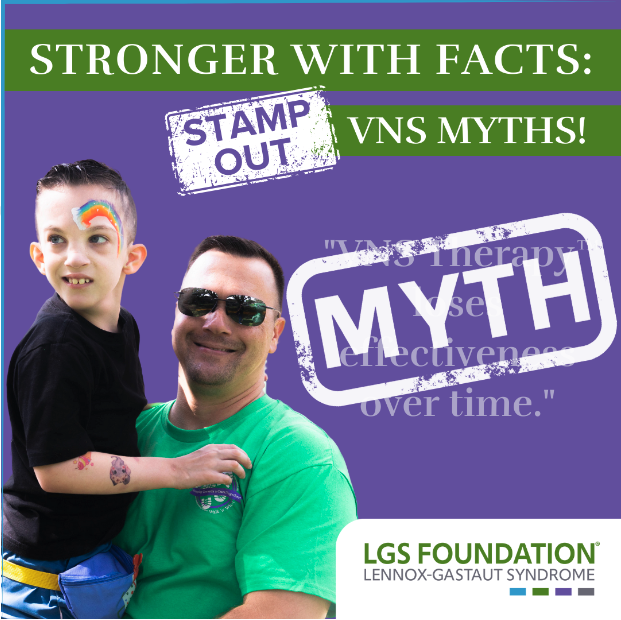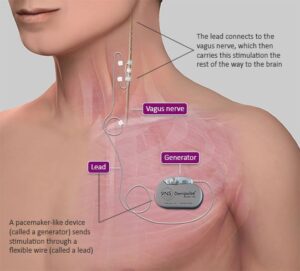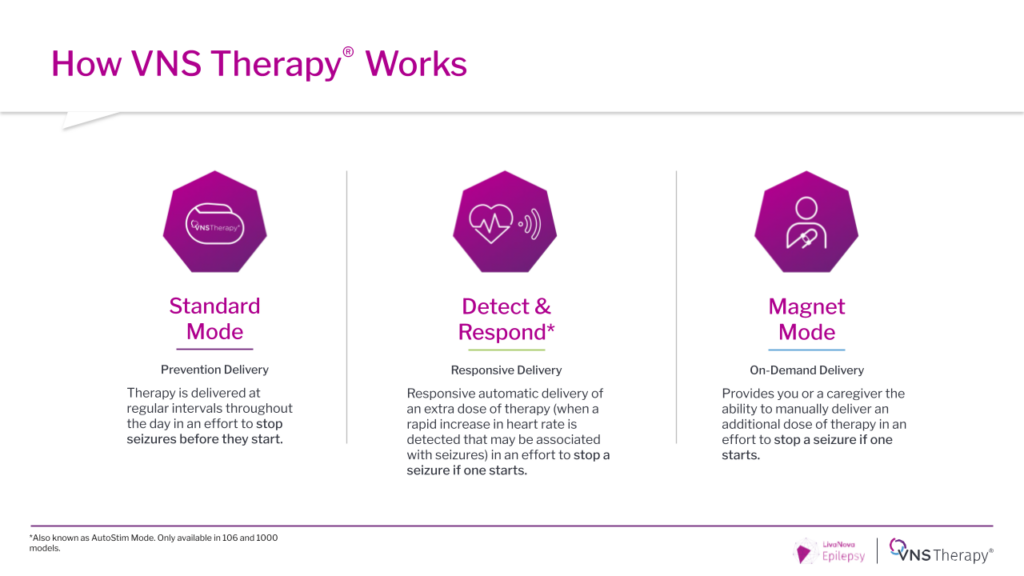Our community is stronger with facts! When it comes to Vagus Nerve Stimulator therapy (VNS Therapy) for seizure reduction, do you know fact from fiction?
 We are Stronger with Facts: Let’s stamp out VNS Myths!
We are Stronger with Facts: Let’s stamp out VNS Myths!
LGS is tough; finding information doesn’t need to be. That’s why we are helping our community separate fact from fiction around Vagus Nerve Stimulation (VNS) Therapy.
Often, information on specific treatments and/or therapies is fraught with inaccuracies, rumors, and other myths regarding the safety and efficacy of such procedures. So, we have partnered with LivaNova to help us all stamp out the VNS myths!
What is VNS Therapy™?
VNS Therapy is an FDA-approved therapy where a device is implanted in the body to stimulate the vagus nerve, much like an artificial pacemaker controls the heart. The implant sends electrical impulses to the vagus nerve, which carries them to the brain. For the right candidate, VNS Therapy can suppress seizures and may reduce seizure frequency. It is rare for this therapy to stop seizures entirely, but it can reduce this.
Why is there confusion?
Misconceptions about VNS Therapy circulate within seizure communities, including ours. A survey in our community revealed that more than 80% of people with LGS try VNS Therapy, but families also reported confusion about the facts. Because LGS is rare, few studies exist on VNS Therapy in LGS patients. It doesn’t help that every LGS patient experience is different. VNS Therapy may make a positive impact on one LGS patient while making little difference or a negative impact on another.
Despite this, what we do know about Vagus Nerve Stimulation Therapy is helpful, and it remains an important therapy option for many LGS patients. The key is having the correct information. Our LGS Community is stronger with facts!
VNS Myths
MYTH BUSTED!
FACT: VNS Therapy is implanted in the neck and chest and stimulates the vagus nerve, which sends signals into the brain.
 VNS is typically an outpatient procedure.
VNS is typically an outpatient procedure.
- Dibue M, et al. Brain and Behavior. 2022. https://pubmed.ncbi.nlm.nih.gov/33188523/
MYTH BUSTED!
FACT: New VNS Therapy pulse generators can be used with the lead from the older models.
It used to be that the older models of the VNS leads could not be used with the new technology because the new pulse generators only had one lead. Now there is a new model of VNS pulse generator that can be used with the old two lead wires. This new model has the latest upgrades.- Detect the heart rate changes during a seizure and then be programmed to give extra nerve stimulation when heart rate changes are seen.
- Can be programmed one time and then ramped up to a therapeutic dose on its own without multiple doctor visits.
- Can be programmed to give stimulation at certain times of day when seizure risk is higher.

MYTH BUSTED!
FACT: VNS Therapy has been shown to further reduce seizures the longer it is in use.
Research shows that the VNS works better over time and a recent study in LGS show those using both the VNS and medication lived longer than those on medications alone. Further, longer use of VNS can lead to improvements in areas of quality of life such as mood, memory, and attention.- At 3 months, 23% of patients have a responder rate of 50% or more.
- At 1 year, 37% of patients have a responder rate of 50% or more.
- At 3 years, 60% of patients have a responder rate of 50% or more.
- At 5 years, 64% of patients have a responder rate of 50% or more.
- At 10 years, 76% of patients have a responder rate of 50% or more.
- Handforth A, et al. Neurology. 1998; 51:48-55. https://pubmed.ncbi.nlm.nih.gov/9674777/
- Morris GL, et al. Neurology. 1999; 53:1731-5. https://pubmed.ncbi.nlm.nih.gov/10563620/
- Kawai K, et al. Epileptic Disord. 2017;19:1-12. https://pubmed.ncbi.nlm.nih.gov/28832004/
- Elliott RE et al. Epilepsy Behav. 2011; 20:57-63. https://pubmed.ncbi.nlm.nih.gov/21144802/
- Elliott RE et al. Epilepsy Behav. 2011; 20:478-83. https://pubmed.ncbi.nlm.nih.gov/21296622/
MYTH BUSTED!
FACT: The median battery life for VNS Therapy devices is typically between 4-8 years depending on the device settings.
Battery life is dependent on a variety of factors including device settings and magnet use. Consequently, the battery life can significantly vary between patients. In most with drug resistant epilepsy, the battery will last between 4-8 years.MYTH BUSTED!
FACT: MRI can be safely performed with an implanted VNS Therapy system provided that specific guidelines are followed.
MRI guidelines are provided to your doctor and are also available below:- Before scheduling your MRI appointment, please contact your neurologist to discuss your upcoming MRI.
- Schedule your MRI appointment. When you call to make an appointment for an MRI, inform the MRI center that you have a VNS and provide the model number of your implanted VNS Therapy device, as well as the name and contact information of your neurologist. This information can be found on the Patient MRI Form which will be provided by your neurologist.
- Before your MRI
- Your neurologist will temporarily turn your VNS Therapy device OFF and give you a copy of the Patient MRI Form to take to the MRI center.
- Attend your MRI appointment
- Remember to bring your Patient MRI Form.
- Inform the radiologist and MRI technicians of your implanted VNS Therapy device and your seizure disorder.
- Do not bring your patient magnet into the MRI scanner room.
- If you feel any discomfort during the MRI, immediately notify the MRI technician.
- After your MRI
- Make an appointment with your neurologist to turn your VNS Therapy device back on.
MYTH BUSTED!
FACT: Airport security systems and other metal detectors should not affect VNS Therapy, nor should the VNS Therapy affect airport metal detectors.
Airport security systems and other metal detectors should not affect the generator or be affected by it. As a precaution, however, move through them at a steady pace; do not linger in the area and stay at least 40 centimeters (16 inches) away from such equipment. Tag deactivators found in many retail stores can interfere with VNS Therapy when it is used near the generator. It can cause accidental activations or stop pulses. Stay at least 60 centimeters (2 feet) away from tag deactivators to avoid potential interference.MYTH BUSTED!
FACT: The most common side effects of VNS Therapy include hoarseness, sore throat, coughing, and shortness of breath. These side effects usually occur when the VNS Therapy™ device is stimulating and often subside over time.
If these effects continue, the doctor can adjust the dosing parameters of the VNS device. The most common adverse event from VNS surgery is infection.- ataxia (loss of the ability to coordinate muscular movement)
- dyspepsia (indigestion)
- dyspnea (difficulty breathing, shortness of breath)
- hypoesthesia (impaired sense of touch)
- increased coughing; infection
- insomnia (inability to sleep)
- laryngismus (throat, larynx spasms)
- nausea
- pain
- paresthesia (prickling of the skin)
- pharyngitis (inflammation of the pharynx, throat)
- voice alteration (hoarseness)
- vomiting.
MYTH BUSTED!
FACT: VNS Therapy is approved for partial onset seizures in patients age 4 years and older who have tried 2 or more anti-seizure medications, but studies show it can have an effect on other seizure types seen in LGS.
VNS has been shown to be most effective at reducing simple partial seizures (aka focal aware seizures), generalized-onset non-motor seizures, and drop attacks in those with LGS.Vagus Nerve Stimulation Therapy is indicated for use as an adjunctive therapy in reducing the frequency of seizures in patients 4 years of age and older with partial onset seizures that are refractory to antiepileptic medications.
The information here is not intended to provide diagnosis, treatment, or medical advice and should not be considered a substitute for advice from a healthcare professional. The content provided is for informational purposes only. LGS Foundation is not responsible for actions taken based on the information included on this webpage. Please consult with a physician or other healthcare professional regarding any medical or health-related diagnosis or treatment options.
Thank you to LivaNova for making this important educational campaign possible.
Updated: 02/14/25 (AM)
